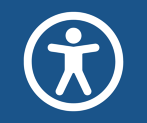
A note from Donna
In many of my professional learning presentations, participants share a common sentiment: “I didn’t know I was creating inaccessible content. I didn’t know what I didn’t know.” These moments are often filled with a mix of surprise, concern, and even a little embarrassment. If you’ve ever felt this way, let me assure you, you are not alone.
Accessibility is a journey, not a destination. None of us started out knowing all the standards, strategies, or tools. What matters most isn’t where you begin but your commitment to learning and improving. Digital accessibility isn’t about shame or perfection. It’s about progress and the meaningful impact we can have when we learn together.
By recognizing gaps in our knowledge, we open the door to growth. Each step we take, whether it’s writing clear alt text, ensuring sufficient color contrast, or simply asking questions, brings us closer to creating a more accessible world. And along the way, we make it easier for someone else to participate, learn, or connect.
So, let’s keep moving forward together. Accessibility work isn’t just technical, it’s transformational. And every small improvement is a step toward access for all.
Yours in accessibility,
Donna
Did you miss the last newsletter? Check out the first edition of the Digital Accessibility Newsletter.
|

Resource Spotlight:
Deep Dive into the ADA title II Rule
Explore the specifics of the ADA Title II rule and its implications for ensuring accessible digital content in K-12 PSUs and state government. This webinar recording is from a presentation by Donna Murray, NCDPI Digital Accessibility Specialist.
|

Accessibility Insights:
External Events and Resources
External events
- November 27, 2024: EAA Webinar Series: Accessibility in Practice: This free webinar, designed to coincide with the European day for people with disabilities, will share messages from people across Europe. Learn how people read with assistive technology, what difference the often small considerations in ebook creation can make, and the impact already being experienced of recent accessibility innovations in digital publishing.
- December 12, 2024: 2024 U.S. Digital Accessibility Legal Update with Lainey Feingold: Stay informed on the evolving digital accessibility legal landscape in this free webinar covering current legal requirements, recent court cases, pending regulations, best practices, and ethical approaches to centering disabled people in digital inclusion efforts.
- 2024-25 South Carolina’s webinar series with USDE OCR National Digital Accessibility Team: The South Carolina Department of Education's Access Academy provides resources and virtual learning sessions focused on accessibility in education, supporting educators in creating inclusive learning environments.
- February 25-27, 2025: Deque Axe-Con: A free virtual conference dedicated to digital accessibility, featuring industry experts who share insights, tools, and best practices to help attendees create accessible digital experiences.
Articles and resources
|

Understanding WCAG:
Using Sufficient Color Contrast
In each newsletter, we will focus on an accessibility topic and its relevant WCAG 2.1 standard(s).
Color contrast is a fundamental element of accessible design that directly impacts how readable and usable your content is for all users. When there is insufficient contrast between text and its background, users—particularly those with low vision or color blindness—may struggle to read or even see your content. Meeting the recommended contrast levels helps ensure your text is legible, improving the experience for everyone.
Beyond accessibility, proper color contrast also enhances the overall usability and aesthetics of your content, making it more engaging and easier to navigate for all users, including those without visual impairments.
Why Color Contrast Matters
Proper color contrast ensures that text stands out from its background, providing clarity and readability in various lighting conditions or for users with visual impairments. Without it, content may become unreadable, reducing its effectiveness and creating barriers for many users.
Tips for Ensuring Adequate Color Contrast
- Use high-contrast color combinations: Opt for dark text on a light background or vice versa. Avoid colors with similar brightness or hue that may blend together.
- Test your content: Use contrast-checking tools (e.g., WebAIM’s Color Contrast Checker or Adobe Color Contrast Analyzer) to evaluate the contrast ratio of text and background colors. Aim for a ratio of at least 4.5:1 for normal text and 3:1 for large text.
- Pair visual emphasis with explicit text: Enhance meaning by including descriptive words, such as "Important:" or "Note:" alongside formatting like bold or highlights. This ensures clarity for all users, especially those who may
- Review color contrast in images of text: Ensure that text within images meets the same contrast requirements as regular text. Low contrast in images of text can make critical information inaccessible to users, especially those with visual impairments or when the image is scaled down or viewed on small screens. Where possible, avoid using text in images altogether and present the information as live text.
Relevant WCAG Standards
|
Digital Accessibility Through Lived Experience
Screen Reader Demo for Digital Accessibility
This video demonstration provides a live example of how screen readers work, illustrating how visually impaired users navigate content online. Viewers gain a better understanding of screen reader functionality and the critical need for clear and descriptive headings, alt text, and navigational elements.

NCDPI Digital Accessibility:
Building A11y Champions!
|
If you have ideas for topics you'd like to see covered in the newsletter, or would like to contribute to a future edition, please reach out via email.
References/links to external websites or tools do not constitute endorsement.
|